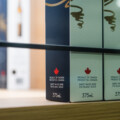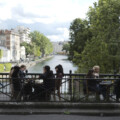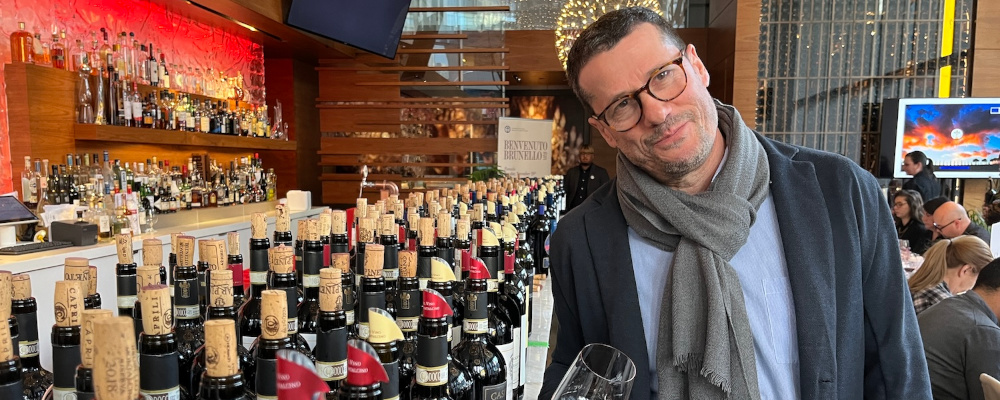Last week in Toronto, more than a hundred wine people (media and trade) were assembled in a fancy financial district restaurant at the very un-Dionysian hour of 9:30 in the morning. The room was set up in a series of numbered tables, and as we filed in to register for the event we were told at which table to sit. Before us at each sitting were four glasses and a list of 70 or so fine red wines from 35 producers that belong in the Consorzio del Vino Brunello di Montalcino.
It was Brunello Day, a tasting event held not just in Toronto, but on the same day in Dallas, Miami, New York, Shanghai, Tokyo, Zurich, and Vancouver. These events were, in turn, smaller versions of a greater series of tastings, called Benvenuto Brunello, organized by the Consorzio and supported abroad by the Italian Trade Agency.
Brunello di Montalcino is one of Italy’s “Big B” success stories, along with its northern luxury wine cousins Barolo and Barbaresco. Until the 1970s, the vineyards around the Medieval hilltop town of Montalcino, about forty kilometres south of Siena in Tuscany, grew mostly Muscat grapes to make sweet white fizzy wine. The resurgence of the Brunello clone of the Sangiovese grape in this small wine region has never slowed down—demand continues to outstrip supply and prices rise correspondently.
Benvenuto began in Montalcino, two weeks before. It ran for four days there, then moved to London for another big show. All of this was in the service of what the Italians call an anteprima, or preview. The Tuscan and U.K. versions would have had all or most of the wines to be released to buyers this year, whereas the satellite versions, like the ones in Canada, would focus on products available in each specific market.
The Toronto-based wine writer Michael Godel was our event host and MC and acted as an ambassador of the Brunello preview. It might be said that Godel “brought” the wines to us, since he and fellow Canadian Brunello ambassador Michaela Morris (who played host at the event in Vancouver) had spent the previous week in Montalcino at the proper anteprima.
Before any wines were poured into our glasses, Godel gave us a preview of the preview, as it were. The bulk of the wines released were from 2019; these were “plain” Brunello di Montalcino DOCG wines. The DOCG wines are distinguished from the more ordinary Rosso di Montalcino, though as Godel pointed out, the winemakers of Montalcino make twice as much of the Brunello as the everyday Rosso, as there is a significantly higher price ceiling on the former.
The rest of the wines were the Riservas. The chief difference for those wines selected to be Riserva is aging. Whereas “regular” Brunello cannot be released to be sold until the first of January “of the year following the end of the fifth year calculated in consideration of the year of harvest,” the rule for Riserva is six years. Accordingly, all of the Riservas poured to be previewed were from 2018, except one outlier from 2016.
Godel brought more than wine; he brought news from the small, prestigious wine region. First, he addressed the vintage just brought in, 2023. He confirmed the bad news from much of Italy: this rainy year was something of a disaster, chiefly because of powdery mildew. A number of producers do not expect to make any Brunello at all from 2023 grapes. In any event, production will be severely limited.
Bad news was followed by good. The 2019 was, by contrast, a “Goldilocks year”: not too hot, not too wet. Godel said one producer told him that making wine in 2019 was a “breeze”. 2019 is predicted to be a “famous vintage”, and the Montalcino winemakers are happy to focus on this good fortune after the heartbreak of the previous six months.

Then, because there is never a dull moment in the world of wine, back to bad news. Or at least not as good news. 2018 was a challenging year, cooler than most. A wine writers’ joke is that vintages like 2018 are called “classic”. There’s truth to the sarcasm, though. Cooler vintages hark back to wines made before the effects of global warming were consistently felt beginning in the late 1990s. Looking on the bright side, Godel told us to look for an expression of “pure Sangiovese” in the 2018 Riservas.
During the tasting proper, I tasted 39 out of the 70 or so wines on offer over three hours. Here’s my verdict: if you can afford and enjoy Brunello di Montalcino, then you have nothing to worry about. Nearly all the wines I tasted showed well. The 2019 wines were generally speaking rich, complex, and showing what the Brits call hedgerow fruit: blackberries. The tannins were still gripping but fine; these wines could be drunk now with a decanting, or better to be put down for a few or more years. If you want to impress your date at a fancy Italian restaurant in 2029, I suggest you order a 2019 Brunello.
If you want to impress your wine nerd friend at a fancy Italian restaurant in 2024, ’25, or ’26, then order a 2018 Brunello di Montalcino Riserva. The 2018 wines sang a softer song. I could see what Godel meant by pure Sangiovese: cherries. These wines showed a red fruit elegance and were more or less ready to go.
If contemporary winemakers are cursed with weather disasters and climate chaos like this summer in Italy, then they are also blessed to be making wine in the information age. Never has so much knowledge about how to shape wine in the cellar been accumulated and disseminated. The enologi of Montalcino knew exactly what to do with their fruit from a cooler year. I predict that as things continue to heat up, fresher vintages like 2018, or 2013 before, will become sought-after rarities.
Recommended for You

Matthew Grills: Joey Chestnut is America

Malcolm Jolley: The comfort of familiar favourites—or the fun of finding new wines?

Malcolm Jolley: An ‘Elbows Up’ wine project everyone can get behind

Malcolm Jolley: Need some summer wines? Look no further than the food-friendly, low-sugar sippers of the sunny Southern Rhône




